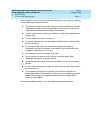
MERLIN LEGEND Communications System Release 6.0
System Manager’s Guide
555-660-118
Issue 1
February 1998
About the System
Page 2-2Background
2
Many of the principles of telephone communications have not changed since
Alexander Graham Bell made the first phone call in 1876. Because learning about
these concepts helps explain how the system works, this chapter begins with
some background information about telephone communications. For a more
detailed history and description, see Appendix B, “About Telecommunications.”
If you are already familiar with the concepts described in this chapter, you can skip
the chapter.
Background 2
Alexander Graham Bell and his assistant, Thomas A. Watson, demonstrated the
first working model of a telephone on March 10, 1876. Bell made the call from a
transmitter in one room to a receiver a few rooms away.
The first telephone installations were set up like that first call, as direct
connections between one telephone and another. When more and more
telephones were installed, it quickly became impractical to have every phone
connected directly to every other phone. Thus, the concept of
switching
developed, that is, all telephones connected physically to all other telephones, but
each telephone could make the electrical cross-connection between itself and
another phone so that the caller was connected to the called party.
Again, as more and more telephones and lines were installed, it became
impractical to have each telephone perform this switching function, so all lines
from all phones were brought into a common place, called a
central office (CO)
or
exchange
(see Figure 2–1) where human operators switched calls at
switchboards. This 2-way connection between the telephone and the CO was
(and still is) called the
local loop.
Eventually, more and more COs were created
and interconnected, until the current global telephone network evolved (see
Figure 2–2
).
As geographic areas expanded and the global telephone network evolved, and as
technological advances became available, switches also evolved and are now
fully automatic and controlled by computers.
There are now also private switches that, rather than being located at the
telephone company’s CO, are located on a company’s premises. These systems,
called
private branch exchanges
(
PBXs
), made sense because most of a
business’ calls are between telephones on site within the company.
The MERLIN LEGEND Communications System includes such a switch, located
on a company’s premises, that offers access to even more powerful telephone
network applications and services. It can operate as a PBX (
Hybrid/PBX mode
)
or
can be set up to operate in one of two other modes that define how the system
works. The system can also use state-of-the-art telephone equipment.


















